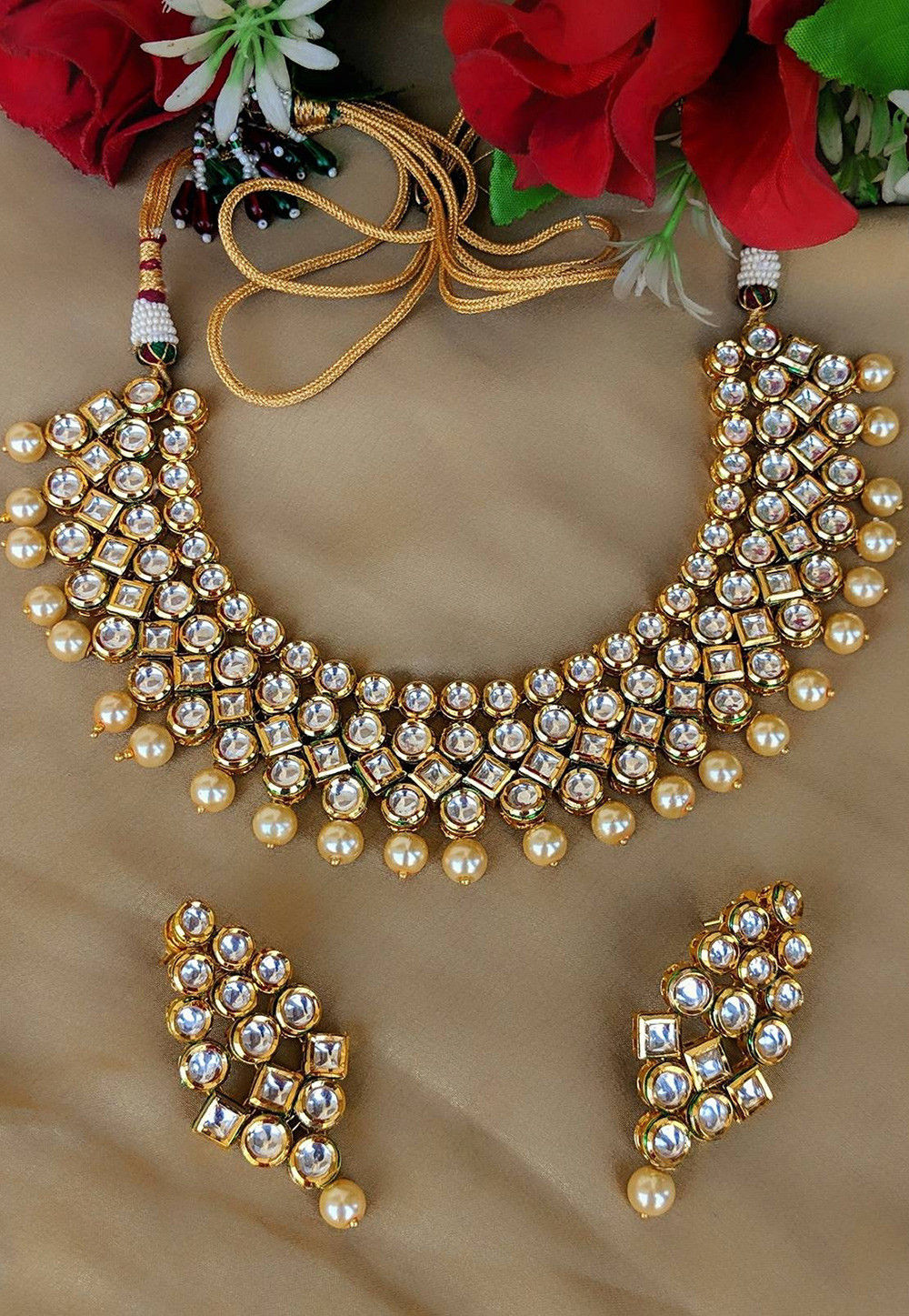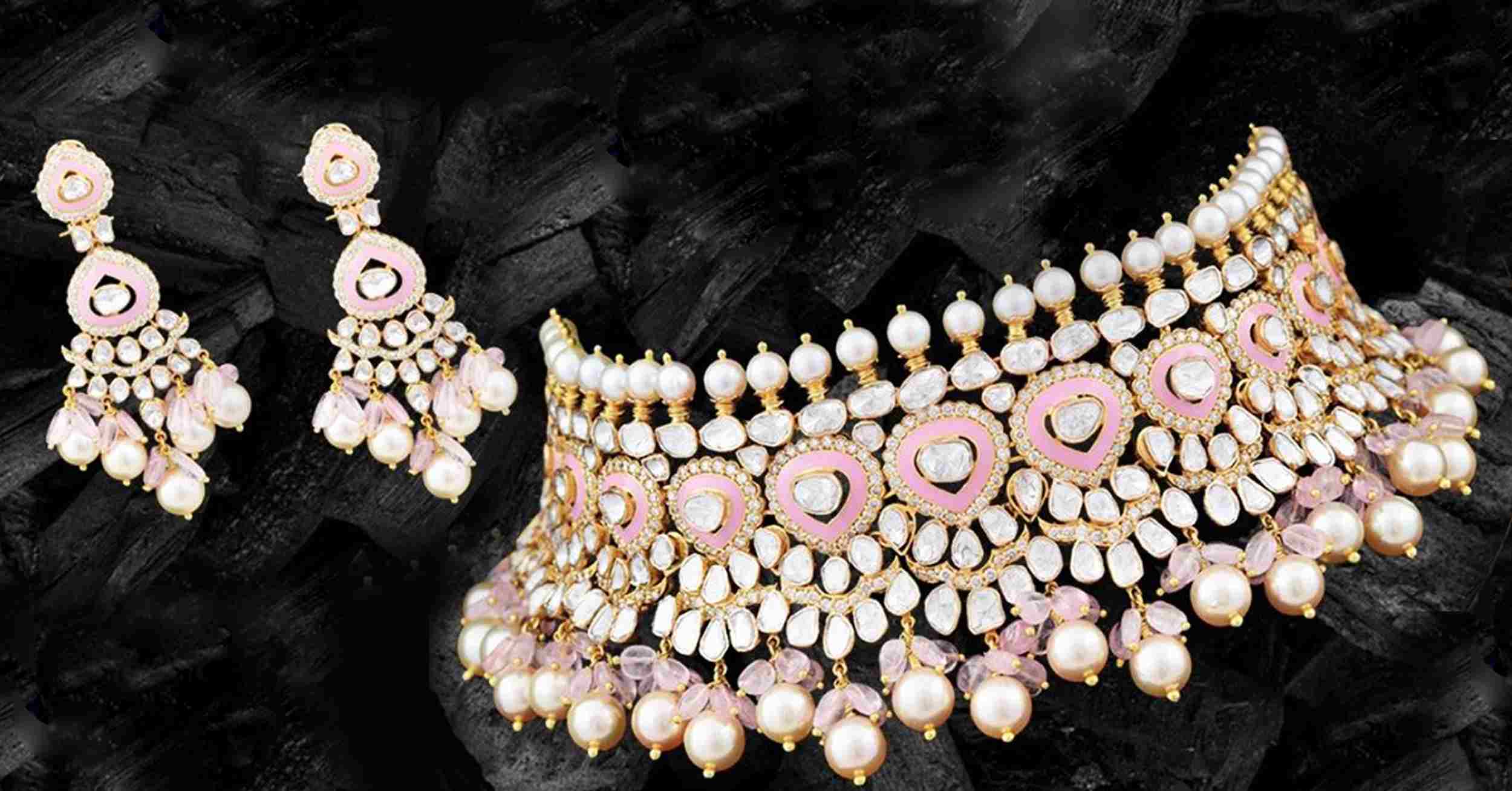Kundan, meaning pure gold, it is a traditional form of Indian gemstone jewelry involving a gem set with a gold foil between the stones and its mount, usually for elaborate necklaces and other jewelry.
India is a country known for its diverse culture, religion, and arts and crafts. It is famous not just for its rich fabrics but also for its traditional jewellery. There’s an abundance of designs, styles, and types for one to choose from. One of the most famous types of jewellery is Kundan, which is an ancient form of jewellery that is adorned with gemstones and gold foil. Kundan is considered to be royal because its production is believed to have originated in the royal courts of Rajasthan centuries ago. Some also call it Bikaneri or Jaipuri jewelry.
The word ‘Kundan’ implies highly refined gold. The jewellery gets its name because of the skilled craftsmanship of encasing glass or gemstones in a base of gold foil made of a highly refined and pure form of molten gold. Its production process also involves enameling with vivid colors on the reverse while the Kundan design is on the front. It has a rich legacy of over 2500 years.
Where Kundan Jewellery is used?
Today, Kundan jewellery is mostly seen in the bride’s traditional wedding trousseau. Originally, it often came as a complete set, comprising of an ornate necklace, with bangles or bracelets and earrings to match. In recent times, you can find these pieces individually as well as in the form of a set. Kundan rings and hair accessories are also available. You will see a lot of rani haars and chokers, Kundan pendants, bangles, earrings, and more. These statement pieces are very elaborate and the work on them is beautiful and intricate. Traditional and heavy, it is perfect for the most special occasions in life. For tighter budgets, imitation Kundan jewelry is a great alternative.
Difference between Kundan, Polki, and Jadau
Kundan, Polki, and Jadau jewelry are three popular types of traditional Indian jewelry known for their intricate craftsmanship and exquisite designs. While they may share some similarities, each type has its unique characteristics and techniques.
Kundan jewelry is crafted by setting gemstones, usually semi-precious, in a gold foil base. The gemstones are secured by carefully placing them in a wax mold and then filling the gaps with molten gold. This process creates a seamless and intricate design, often enhanced with enamel work. Kundan jewelry is renowned for its elaborate and regal appearance.
Polki jewelry, on the other hand, uses uncut diamonds set in gold. These diamonds have a natural, raw appearance with a flat base and a faceted top. Polki jewelry is known for its shimmering, vintage appeal and is often used to create statement pieces such as necklaces, earrings, and bracelets.
Jadau jewelry involves embedding precious and semi-precious gemstones in gold. It is a highly skilled technique that originated in Rajasthan, India. Jadau pieces often feature intricate and elaborate designs, showcasing meticulous stone setting, filigree work, and Meenakari (enamel) detailing. Jadau jewelry is known for its rich heritage and timeless elegance.
While Kundan, Polki, and Jadau jewelry may have overlapping features, the primary distinction lies in the type of gemstones used, the setting techniques, and the overall aesthetic appeal. Each style offers a unique charm and is cherished for its cultural significance and artistic value in the world of traditional Indian jewelry.
What can you tell us about the history of Kundan jewellery?
Kundan jewelry holds a rich and fascinating history that dates back centuries in the Indian subcontinent. The origins of Kundan jewelry can be traced to the royal courts of Rajasthan and Gujarat during the Mughal era. It flourished under the patronage of Mughal emperors, who were known for their love of opulence and fine craftsmanship.
The term “Kundan” refers to the technique used to create this intricate jewelry. The word “Kundan” itself means “pure gold” in Sanskrit. The process involves setting gemstones, usually semi-precious, into a gold foil base. Skilled artisans shape the gold into delicate settings and secure the gemstones by placing them in a wax mold. The gaps are then filled with molten gold, allowing the gemstones to be firmly held in place.
Kundan jewelry gained popularity during the Mughal period and was favored by royalty and nobility. It was often adorned with precious gemstones like diamonds, emeralds, rubies, and pearls. The intricate craftsmanship and exquisite designs of Kundan jewelry reflected the grandeur and luxury of the Mughal courts.
Over time, Kundan jewelry became an integral part of Indian bridal adornment. It continues to be highly sought after for weddings and other special occasions. The art of crafting Kundan jewelry has been passed down through generations of skilled artisans, who meticulously maintain the traditional techniques and designs.
Today, Kundan jewelry stands as a testament to the rich cultural heritage and artistic traditions of India. Its timeless beauty and regal allure continue to captivate jewelry enthusiasts worldwide, making it a cherished symbol of elegance and sophistication.
What is the procedure for crafting Kundan jewellery?
 The process of making Kundan jewellery starts with the making of A ghat in 22 karat gold, which is known as Gadhafi—unique pieces structured with golden strips. The image of a typical mold-like framework is set according to the design, using thin golden strips which are then cut, coiled, and shaped. This is the most important step to establish the foundation of the piece.
The process of making Kundan jewellery starts with the making of A ghat in 22 karat gold, which is known as Gadhafi—unique pieces structured with golden strips. The image of a typical mold-like framework is set according to the design, using thin golden strips which are then cut, coiled, and shaped. This is the most important step to establish the foundation of the piece.
The second step is khudayi, which involves engraving the outer surface with the required designs and patterns. The framework is filled with lac (a type of wax) or gold and then engraved in this process. This step basically includes etching the planned pattern or design on the surface of the jewellery piece.
Kundan jewellery is basically created using glass stones. This is a traditional Rajasthani jewellery made of glass Polki. Basically, no diamonds (whether finished or unfinished) are used to create Kundan jewellery pieces. Kundan jewellery is created using glass stones, which are then set in gold or silver. This makes it deceptively similar looking to Polki or Jadua. Kundan jewellery is made from precious metals and has a lot of intricate detailing work at the back. This is a popular choice with many brides-to-be.
Steps followed in Creating Kundan Jewellery
Kundan jewellery is created by setting carefully shaped, uncut diamonds and polished multi-colored gemstones into an exquisitely designed pure gold or faux metal base. The elaborate process begins with the skeletal framework called Ghaat. Thereafter, the Paadh procedure takes place, during which wax is poured onto the framework and molded according to the design.
Following this is the Khudai process when the stones or uncut gems fit into the framework. Meenakari Jewellery design process then involves enameling to define the design details. Next, the Pakai process involves gold foils that hold the gems onto the framework; these are cold-soldered using burnishing techniques. Finally, the gems are polished using the Chillai process.
How long does it take to craft one piece of Kundan jewellery?
Kundan pieces are extremely intricate and involve a lot of skilled labor. Each piece is hand-finished, which translates into countless hours of hard work by skilled artisans. The time taken to craft a small piece of Kundan jewellery could vary anywhere between two to four months, depending on the craftsmanship and the intricacy of the chosen design.
What are the most common motifs used in Kundan jewellery?
There are no predetermined criteria for using specific motifs in Kundan jewellery. However, the most common sources of inspiration include nature and architecture. Different aspects of these are employed to construct the motifs, with florals being a recurring favorite. The beautiful shapes of tulips, lotuses, and carnations are usually immortalized within the motifs of the pieces.
How can one identify real Kundan from fake pieces?
Adequate knowledge of real Kundan pieces is extremely important while shopping. A basic understanding of jewellery and craftsmanship is essential to make out the difference between fake and real pieces. However, since Kundan jewellery is set in 24 karat gold, it should come with quality certifications from the jeweler. You can also check for authentic stamps on the jewellery pieces to cut down the risk of fakes.
Where can you buy Kundan jewellery in India?
Although Rajasthan is the most popular state in India for Kundan jewellery, you will find jaw-dropping designs all over the country. Most big cities and metros have designers that offer exquisite Kundan sets. You can also get your beautiful designs online for both brides and grooms by customizing them on various sites.
Final Thoughts
In conclusion, Kundan jewellery is a wonderful reminder of the elite Rajkumar and Rajkumaris that once ruled India. It is traditional, royal, and a representation of India’s rich heritage and grandeur. Although it’s a long and arduous process, each painstakingly made piece of Kundan’s work is definitely worth the purchase. So if you want something intricate, elaborate, and a reflection of skilled craftsmanship, then it is the right choice for you. It will make a wonderful addition to a regal and elegant bridal trousseau.






